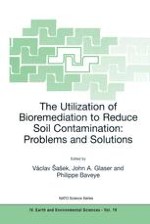
2003 | OriginalPaper | Buchkapitel
Rapid Detection/Identification of Microbes, Bacterial Spores, Microbial Communities, and Metabolic Activities in Environmental Matrices
verfasst von : D. C. White, A. M. Peacock, R. Geyer, Y.-J. Chang, Ying-Dong M. Gan, C. A. Lytle
Erschienen in: The Utilization of Bioremediation to Reduce Soil Contamination: Problems and Solutions
Verlag: Springer Netherlands
Enthalten in: Professional Book Archive
Aktivieren Sie unsere intelligente Suche, um passende Fachinhalte oder Patente zu finden.
Wählen Sie Textabschnitte aus um mit Künstlicher Intelligenz passenden Patente zu finden. powered by
Markieren Sie Textabschnitte, um KI-gestützt weitere passende Inhalte zu finden. powered by
Modern molecular methods such as lipid biomarker analysis (LBA) and PCRDenaturing Gradient Gel Electrophoresis (DGGE) of rDNA or functional genes have enabled sensitive and quantitative assessment of in situ microbial communities that is independent of isolation and culture of the microbes. Application of artificial neural network analysis (ANN) to biomarker data has demonstrated a powerful means to characterize soil, marine and deep subsurface microbial communities. This analysis has provided accurate detection of bioavailability, bioremediation effectiveness, and rational end points for remediation based on the community microbial ecology. Sequential high pressure/temperature extraction greatly shortens sample-processing time and increases the recovery of lipid biomass from soils. Sequential extraction by supercritical CO2 and/or accelerated solvent extraction (ACE) lyses cells and allows sequential recovery of neutral lipids, then polar lipids, and facilitates recovery of DNA. The extracted residue is then derivatized in situ and re-extracted with supercritical CO2 or hexane with ACE to yield dipicolinic acid originating from bacterial spores and ester-linked hydroxy fatty acids derived from the lipopolysaccharide of Gram-negative bacteria. Once extracted, components in each fraction are separated by capillary high performance liquid chromatography (HPLC) with solvent systems compatible with electrospray ionization and analyzed by tandem quadrupole mass spectrometry (HPLC/ESI/MS/MS) and capillary gas chromatography/mass spectrometry (GC/MS). HPLC utilizing electrospray ionization (ESI) provides the potential to analyze intact lipid biomarkers and provides greater insights into the viable biomass, community composition and physiological status than with previous techniques. Use of HPLC/ESI/MS/MS enables analysis of respiratory quinones, diacylglycerols, and sterols from the neutral lipids. Also, the structures of intact phospholipids that have been collisionally dissociated can be determined at sensitivities (for synthetic molecules) of ≈ 90 attomol/μL (concentration of total lipids in a single E. coli) Moreover HPLC/ESI/MS/MS also enables analysis/detection of the isoprenoid tetraethers of the Archaea, Ornithine lipids of Gram-negative bacteria signaling for bio-available phosphate, and the lysyl esters of phosphatidyl glycerol of Gram-positive bacteria. This expanded LBA not only facilitates recovery of DNA for highly specific PCR amplification but provides deeper insight into predicting in situ metabolic activities without disturbance artifacts. In addition, the analysis is based on the responses to microniche environments—the Holy Grail of microbial ecology.